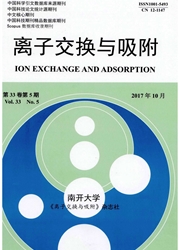

 中文摘要:
中文摘要:
采用响应面法对纳米氢氧化铝-聚丙烯酰胺复合絮凝剂吸附Cd(II)过程进行了拟合和优化,分别以pH值、温度和Cd(II)浓度为自变量,研究了其对响应值镉离子最大吸附量的影响,并通过吸附动力学方程和吸附等温线数据对吸附机理进行了探讨。结果表明,采用响应面法对pH值、温度和Cd(II)浓度3个自变量进行优化后得出最大吸附量为79.07mg/g,其最优条件为:pH 6.35,镉离子浓度91.36mg/L,温度50℃;氢氧化铝-聚丙烯酰胺对Cd(II)的吸附在120min内达到平衡,且吸附动力学数据符合准二级动力学模型,表明吸附过程包含化学吸附;吸附速率的控制步骤是吸附脱附平衡步骤;吸附等温线数据与Langmuir吸附等温模型相一致,表明镉离子在氢氧化铝-聚丙烯酰胺表面形成的是单层吸附层。
 英文摘要:
英文摘要:
The effects of operating parameters such as pH, Cu(II) concentration and temperature on the Cd(II) adsorption were investigated for Al(OH)a-polyacrylamide by using a response surface methodology (RSM), and the adsorption characteristics and mechanism were discussed based on the adsorption kinetics and thermodynamic. Results showed that Optimum Cd(II) uptake of 79.07mg/g was achieved at pH 6.35, Cd(II) concentrations 91.36mg/L, and temperature 50℃. The adsorption equilibrium was arrived at 120min, the adsorption process can be well described by the Pseudo-second-order kinetic model, and included chemical adsorption. Particle diffusion is not the only control step of adsorption, also included membrane diffusion. The experimental data of isotherm followed the Langmuir isotherm model, it showed Cd(II) in Al(OH)a-polyacrylamide belong to monolayer adsorption.
 同期刊论文项目
同期刊论文项目
 同项目期刊论文
同项目期刊论文
 期刊信息
期刊信息
